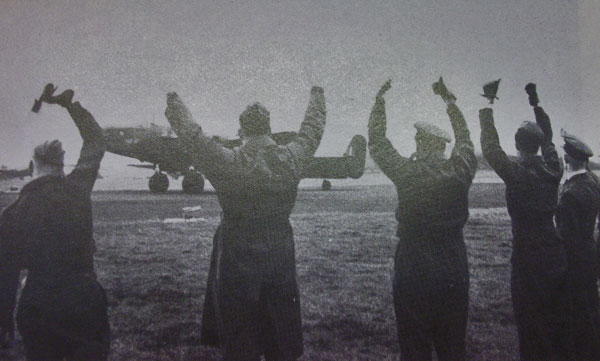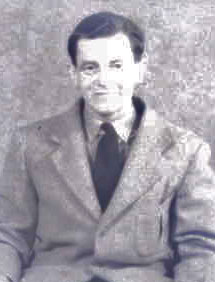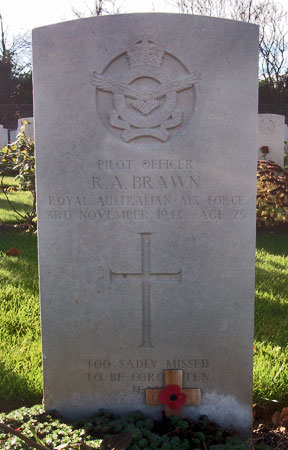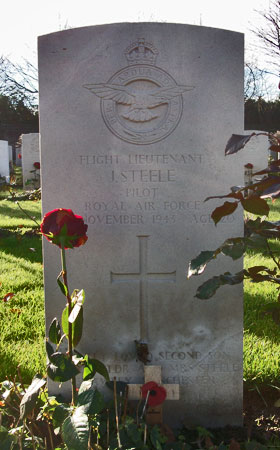
During the morning of the 3rd November 1943 the crew of this 76 Squadron aircraft took off from Holme on Spalding Moor airfield to undertake a test flight in the locality of the airfield, on paper it was recorded as being an "air and gun test". On board were six members of a regular 76 Squadron crew (minus the navigator) and also a female civilian passenger who was was an "expert in the MkXIV bombsight". The main purpose for the flight appears to have been one of a few possibly reasons, or possibly all of them; so that she could set up and test the bombsight in the new Halifax, and / or was offering or sharing knowledge of its use with the bomb aimer. Halifax LK681 was a new aircraft, with just five hours flying time to it's credit so she may have been setting up the bombsight. She had worked in the development of the Mk.XIV bombsight that the Halifax was fitted with at the time and had been involved in a hands-on role in explaining and sharing knowledge about how the bombsight worked with bomb aimers to give them a better understanding of the equipment, which would then hopefully ensure that the accuracy of their bombing was improved. She had worked across the range of the Bomber Command groups giving bomb aimers classroom and also onboard aircraft one to one instruction. Therefore her setting up the equipment and/or giving the bomb aimer some form of training would both fit. Reports elsewhere on the internet about it being some form of special trial flight to test a new type of bombsight would seem to me to not be correct. Had this been the reason for the flight I would doubt that a 76 Squadron Halifax would be used when the Royal Aircraft Establishment, Farnborough, who would have developed the equipment, had access to Halifaxes in their care and would have used their own aircraft to test new equipment.
On the morning of 3rd November 1943 the aircraft took off from Holme on Spalding Moor and was being flown reasonably low around the general area of the airfield, probably keeping the ground in sight so that the civilian could view the ground through the viewfinder on the bombsight. Low cloud or mist was present over the southern side of the Yorkshire Wolds at the time of the flight and it seemed likely in that in trying to assist in keeping the ground in site the aircraft was allowed to be flown much closer to the ground than would normally be expected in regular flying. The pilot was believed to have tried to keep below the cloud base but as the aircraft was flown over ground rising to 300 feet above sea level (which was not seen because of the cloud) and not over the flatter plain around the airfield there was not enough height in which to avoid a crash. The aircraft flew into the ground at 11.55hrs between Moneypot Hill Farm and Lair Grange Farm, between Market Weighton and South Dalton, and broke up across the fields. Some of the occupants of the aircraft were thrown out of the aircraft as it broke up and fires developed in the wreckage. Mr G J Turner, of Holmedale farm, gave a statement to the Court of Inquiry stating that he and other farmworkers had seen the aircraft flying very low just before the crash, they then heard the crash and then went to the crash site and pulled everyone clear of the fire. Kirby, Laskie and Kneale were sadly found to have died at the crash site. An ambulance or ambulances were soon on the scene and Steele, Welch and Miss Robson (and probably Brawn) were all taken to Driffield EMS Hospital where sadly they all died over the coming hours.
The crew's regular navigator P/O Frederick Philip Graham Hall RAFVR (159448) was not part of the crew on this flight, as the flight was to have been in the locality of the airfield there was no need for the navigator to be present. He was preparing navigation charts for operations that evening to Dusseldorf and heard that the aircraft had crashed while collecting his parachute later that afternoon. Fred Hall later joined F/O Bolt's crew and finished his tour, gaining the DFC for his actions in March 1944 on Ops to Nuremberg. In May 1999 he accompanied Ken Reast, Dick Barton and Albert Pritchard when they located the crash site with permission from Lord Hotham, of Dalton Hall and thus confirming the location for the modern-day. William Chorley's superb book "To See Dawn Breaking" gives an account of the events of 3rd November 1943 by Fred Hall in his own words. Air historians Albert Pritchard, Eric Barton and Ken Reast accompanied Fred Hall to the site and located small fragments on the surface at the crash site in May 1999 with permission from the landowner, confirming the crash location.
Pilot - F/Lt James Steele RAFVR (127895), aged 20, of Crawley, Hampshire. Died of injuries. Buried Harrogate Stonefall Cemetery, Yorkshire (C.D.10).
Flight Engineer - Sgt Jeffrey George Kirby RAFVR (1453264), aged 27. Cremated City of London Crematorium, Manor Park, London.
Bomb Aimer - F/O William Laskie RAFVR (131957), aged 20, of Dundee. Buried Balgay Cemetery, Dundee.
Wireless Operator / Air Gunner - Sgt Derek Kneale RAFVR (1450874), aged 20, of Liverpool. Buried West Derby Cemetery, Liverpool.
Mid Upper Gunner - P/O Roy Arthur Brawn RAAF (420611), aged 25, of Ballina, New South Wales, Australia. Buried Harrogate Stonefall Cemetery, Yorkshire (C.D.8).
Rear Gunner - F/Sgt Henry Maxwell Welch RCAF (J/19121), aged 25, Thornloe, Ontario, Canada. Died of injuries. Buried Harrogate Stonefall Cemetery, Yorkshire (C.D.9).
Passenger - Miss Dorothy Robson BSc, aged 23. Of Hartlepool, Durham. Died of injuries. Cremated.


Dorothy Robson and a general memorial at Eden Camp, North Yorkshire for 76 Squadron personnel which also commemorates her. She was born on 10th November 1919 in Guisborough, Yorkshire and was the daughter of Shafto and Myra Lilly (nee Moore) Robson. The family later moved to Hartlepool where her father ran a chemist shop. In the late 1930 she attended Leeds University and gained a BSc degree in Physics. She tried to join the RAF in 1940 but was rejected because of her height so joined the Ministry of Aircraft Production and later served at the Royal Aircraft Establishment (R.A.E.) at Farnborough. She became a leading figure in bombsight development, working on the Mark XIV (or Blackett) bombsight with the primary inventor Patrick Blackett. The Mk.XIV replaced the older CSBS version and became the most widely used bombsight in British aircraft. Dorothy took an active role in training bomb aimers in their equipment at airfield level both within No.4 and No.6 Groups as well within the Lincolnshire groups. She is not officially recorded on the Commonwealth War Graves Commission casualty list as she was not serving as a member of the armed forces, she is simply listed there as a civilian, Miss D. Robson and as dying at Market Weighton. While her name is not recorded as fully as it should be in official sources her name and the important role she played in the development and training aircrew in the use of bombsights has been recorded in a number of books and websites in more recent years and her name should not be forgotten. She is commemorated on the main war memorial at Hartlepool. She was cremated her wish was that her ashes by scattered from an aeroplane. On 9th November 1943 a Tiger Moth belonging to 1664 Heavy Conversion Unit and crewed by G/C Norman Sinclair MacGregor DFC RCAF (C/551) and W/C David Walter Sealy Clark DFC RAF (36213) took to the air to undertake her wishes.
Martin Bowman claims in his book "Bomber Command, Reflections of War: Volume 3" that she has a grave in "Pocklington Road Cemetery" but does not state where this cemetery is. This is not clearly correct.


Henry Welch was born on 8th December 1917 in the Kerns Township, Ontario, Canada and was the son of Henry Tremaine and Elizabeth Ann (nee Rankin) Welch. After leaving school in 1932 he worked in farming with / on his father's farm. He was from a large family and one of his brothers, John Alexander Welch, served in the UK with the RCAF as a wireless operator / air gunner with 405 Squadron and returned to Canada having been awarded the DFC in 1945. His father, Henry (Snr) was well into his eighties by the time war broke out and while he had a number of much older children to a previous marriage loosing two young sons to RCAF overseas service and a third to the Canadian Army. Henry (Jnr) enlisted for RCAF service on 10th July 1942 at North Bay, Ontario and after basic training he was awarded his Air Gunner's flying badge on 30th December 1942. On arrival in the UK he trained at 24 OTU and 1663 HCU before posting to 76 Squadron on 15th August 1943. He received a commission to the rank of P/O on 28th October 1943. Up until his death he had flown fourteen operational flights with 76 Squadron. He died of injuries sustained in the crash of Halifax LK681 on 3rd November 1943 at around 22.30hrs at Driffield Hospital and was buried at Stonefall Cemetery on 6th November 1943.


Roy Brawn was born on 30th May 1918 at Ballina, New South Wales, Australia and was the son of Richard Henry and Alice May Brawn. After leaving school he worked in farming before taking up an apprenticeship as a printer's compositer for the "North Coast Beacon" newspaper at Tintenbar. He married Jean Mary Elliott while in Australia. He enlisted for RAAF service on 8th November 1941 in Sydney and after training in Australia was awarded his air gunner's flying badge on 17th September 1942. He left Australia in mid-October 1942 and the sailing to the UK took over a month. After arriving in the UK over the coming months he trained at 7 AGS, 20 OTU and 1663 HCU before being posted to 76 Squadron on 30th June 1943. His first operational flight with 76 Squadron was on 4th July 1943 but he returned to 1663 HCU on 8th August 1943 for a week, returning to 76 Squadron. He received a commission to the rank of P/O on 20th October 1943 and had flown seventeen operational flights up to his death. The photograph of him shown above was found in his RAAF service file but as a negative image. His service file also contained letters and other documents relating to the accident, stating that he died at 12.30hrs on 3rd November 1943 in Driffield Hospital, yet his death was registered in the Howden district (not the Buckrose district as it should have). He may well have died on the way to the hospital and was only pronounced dead on arrival. He was buried at Stonefall Cemetery on 6th November 1943.

James Steele received a commission to the rank of P/O on probation on 7th August 1942 and rose to F/O six months later. He died later the same day on 3rd November 1943 and was buried at Stonefall Cemetery on 6th November 1943. He was in the rank of Acting F/Lt at the time of his death. The photograph shown at the top of this page is a reasonably famous one and shows Jimmy Steele and his crew about to take off from an operational flight on 22nd October 1943 for a flight to bomb Kassel.
William Laskie received a commission to the rank of P/O on probation on 9th October 1942 and rose to F/O six months later.